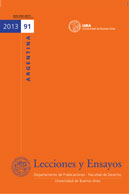Argumentos de derecho romano en el actual derecho internacional: ocupación y prescripción adquisitiva
Keywords:
origins of international law, roman law, international arbitration, international court of justiceAbstract
In his Private Law Sources and Analogies of International Law (1927), Hersch Lauterpacht claimed that many rules and concepts of international law stemmed from private law. He also showed that it was common practice in international adjudication and arbitration to look for inspiration there. The rules of private law that had found their way to international law were often common to the great municipal law systems. Many had their origins in Roman private law. This article examines whether and how the International Court of Justice has made use of Roman law rules and concepts. Roman law can be thought to fulfil its role as a source of inspiration for international law in three ways. First, it might have served as a direct historical source during the formative period of the modern law of nations. Second, it might have served as an indirect historical source because of its enduring impact on the great municipal law systems afterwards. Thirdly, it might still be considered ratio scripta, the expression of
a timeless and universal law. For the purpose of examining which of these roles Roman law plays in the eyes of the ICJ, the analysis is restricted to two examples of private law analogies: occupation of terra nullius and acquisitive prescription.
Downloads
References
ALCIATUS, Andreas, Consilia 52.20 en Opera omnia, 1571.
ALEXANDROWICZ, “The Role of Treaties in the European-African Confrontation in the Nineteenth Century”, en A.K. MENSAH-BROWN (ed.), African International Legal History, 1975.
ANAYA, S. J., Indigenous People in International Law, 1996.
ANDREWS, “The Concept of Statehood and the Acquisition of Territory in the Nineteenth Century”, 94 LQR, 1978.
ANGHIE, “Finding the Peripheries: Sovereignty and Colonialism in Nineteenth-Century International Law”, 40 Harvard ILJ, 1999.
— “Francisco de Vitoria and the Colonial Origins of International Law”, 5 Socl and Leg Stud, 1996.
ANZILOTTI, D., Cours de droit international, traducción. G. Gidel, 1929.
BALDUS, C., Regelhafte Vertragsauslegung nach Parteirollen, 2 vols., 1998.
BATTAGLINI, “Il riconoscimento internazionale dei principi generali del diritto” en Le droit international à l’heure de sa codification. Etudes en l’honneur de Roberto Ago, 1987.
BECKET, “Questions d’intérêt général dans la jurisprudence de la Cour Permanente de Justice Internationale”, 50 RCADI, 1934.
BELLOMO, M., The Common Legal Past of Europe 1000 – 18000, 1995.
BERMAN, “The Concept of Aboriginal Rights in the Early History of the United States”, 27 Buffalo Law Review, 1978.
BLUM, Y., Historic Titles in International Law, 1965.
BROWNLIE, I., Principles of Public International Law, 4th ed., 1980.
BUCKLAND, W. W., A Text-Book of Roman Law from Augustus to Justinian, 1921.
CASTELLINO, J. y ALLEN, S., Title to Territory in International Law. A Temporal Analysis, 2003.
CHENG, B., General Principles of Law as Applied by International Courts and Tribunals, 1987.
COHEN, “The Spanish Origin of Indian Rights in the Law of the United States”, 31 Georgetown LJl, 1942.
— Felix S. Cohen’s Handbook of Federal Indian Law, 2nd ed., 1989.
CRAWFORD, J., The Creation of States in International Law, 1979.
DE VISSCHER, C., Théories et réalités en droit international public, 4th ed., 1970.
DICKASON, “Jus Gentium Takes on a New Meaning”, en L.C. GREEN y O.P. DICKASON, The Law of Nations and the New World, 1989.
EMER DE VATTEL, Le droit des gens, ou principes de la loi naturelle, 1758.
FAUCHILLE, P., Traité de droit international public, 8va ed., 1925.
FISCH, “Africa as Terra nullius: The Berlin Conference and International Law”, en S. FORSTER, W.J. MOMMSEN, y R. ROBINSON (eds.), Bismarck, Europe and Africa, 1988.
FISCH, J., Die europäische Expansion und das Völkerrecht, 1984.
FITZMAURICE, “The Law and Procedure of the International Court of Justice: General Principles and Substantive Law”, 27 BYbIL, 1950.
— “The Problem of Non Liquet: Prolegomena to a Restatement” en R. Ago et al. (eds.), Mélanges offerts à Charles Rousseau, 1974.
FRIEDMANN, “The Use of “General Principles” in the Development of International Law” en L. Gross (ed.), International Law in the Twentieth Century, 1969.
GENTILIS, Albericus, De jure belli libri tres, 1758.
GILL, T. y HEERE, W. (eds.), Reflections on Principles and Practices of International Law. Essays in Honour of Leo J. Bouchez, 2000.
GRAVESON, “Hersch Lauterpacht”, 10 ICLQ, 1961.
GREWE, W. G., The Epochs of International Law, Trad. de M. Byers, 2000.
GROCIO, Hugo, De jure belli ac pacis libri tres, 1625.
— Mare liberum, 1609.
GUGGENHEIM, P., Traité de droit international public, 1967.
HALL, W. E., A Treatise on International Law, 8va ed., 1924.
HANKE, L., The Spanish Struggle for Justice in the Conquest of America, 1965.
HELPS, A., The Spanish Conquest in America, 1900.
HERCZEGH, G., General Principles of Law and the International Legal Order, 1969.
HILL, N., Claims to Territory in International Law and Relations, 1945.
HOCHSTRASSER, T.J., Natural Law Theories in the Early Enlightenment, 2000.
HOLLAND, H. E., Studies in International Law and Diplomacy, 1898.
JENKS, “Hersch Lauterpacht: The Scholar as a Prophet”, 36 BYbIL, 1960.
JENNINGS, R. y WATTS, A. (eds.), Oppenheim’s International Law, 9na ed., 1992.
JENNINGS, R., The Acquisition of Territory in International Law, 1963.
KASER, M., Das Römisches Privatrecht, 2da ed., 1971.
KEENE, E., Beyond the Anarchical Society. Grocio, Colonialism and Order in World Politics, 2002.
KELLER, A. S., LISSITZYN, O.J. and MANN, F. J., Creation of Rights of Sovereignty through Symbolic Acts 1400-1800, 1938.
KELLEY, “Civil Science in the Renaissance: Jurisprudence in the French Manner”, 2 J Hist of Ideas, 1981.
KISCH, G., Studien zur humanistischen Jurisprudenz, 1972.
KOSKENNIEMI, M., The Gentle Civilizer of Nations. The Rise and Fall of International Law 1870-1960, 2001.
LAMMERS, “General Principles of Law Recognized by Civilized Nations” en F. Kalshoven (ed.), Essays on the Development of the International Legal Order, 1980.
LAUTERPACHT, E., “Sir Hersch Lauterpacht, 1897-1960”, 8 EJIL, 1997.
— , International Law, 1973.
LAUTERPACHT, H. (ed.), Oppenheim’s International Law, 8va ed., 1948.
— , “General Rules of the Law of Peace”, en LAUTERPACHT E. (ed.), International Law, Being the Collected Papers of Hersch Lauterpacht, 1970.
— , “Some Observations on the Prohibition of “Non Liquet” and the Completeness of the Law”, en VAN ASBECK, F.M. al. (eds.), Symbolae Verzijl, 1958.
— , “The So-Called Anglo-American and Continental Schools of Thought in International Law”, 12 BYbIL, 1931.
— , Private Law Sources and Analogies of International Law (With Special Reference to International Arbitration), 1927.
— , The Development of International Law by the International Court of Justice, 1958.
— , The Function of Law in the International Community, 1933; 2nd ed., 1973.
LESAFFER, “An Early treatise on Peace Treaties: Petrus Gudelinus between Roman Law and Modern Practice”, 23 J Legal Hist , 2002.
— “Charles V, monarchia universalis, and the Law of Nations (1515-1530)”, 71 Legal Hist Rev, 2003.
— “The Grotian Tradition Revisited: Change and Continuity in the History of International Law”, 73 BYbIL, 2002.
— “The Scholar as a Judge: Romeins recht en algemene beginselen van privaatrecht bij sir Hersch Lauterpacht (1897-1960)”, en E. J. BROERS y B. VAN KLINK (eds.), De rechter als rechtsvormer, 2001.
— “The Medieval Canon Law of Contract and Early Modern Treaty Law”, 2 J. Hist. Int’l L, 2000.
LÉVY, J. P. y CASTALDO, A., Histoire du droit civil, 2002.
LINDLEY, M., The Acquisition and Government of Backward Territory in International Law, 1926.
MACGIBBON, “The Scope of Acquiescence in International Law”, 31 BYbIL, 1954.
MCNAIR, “Hersch Lauterpacht”, Proceedings of the British Academy, 1961.
— “The General Principles of Law Recognised by Civilised Nations”, 33 BYbIL, 1957.
MORENO QUINTANA en Right of Passage over Indian Territory, 1960.
MORRIS, “International Law and Politics. Towards a Right of Self-Determination for Indigenous Peoples”, en M.A. JAIMES (ed.), The State of Native America. Genocide, Colonization and Resistance, 1992.
MULDOON, “Medieval Canon Law and the Formation of International Law”, 81 Zeitschrift der Savigny-Stiftung für Rechtsgeschichte, kanonistische Abteilung, 1995.
— “The Contribution of the Medieval Canon Lawyers to the Formation of International Law”, 28 Traditio, 1972.
MUNKMAN, “Adjudication and Adjustment – International Judicial Decisions and the Settlement of Territorial and Boundary Disputes”, 46 BYbIL, 1972.
OPPENHEIM, L., International Law, 1905.
PAGDEN, “Dispossing the Barbarian: The Language of Spanish Thomism and the Debate over the Property Rights of the American Indians”, en A. PAGDEN (ed.), The Languages of Political Theory in Early Modern Europe, 1987.
PAGDEN, A., Lords of All the World. Ideologies of Empire in Spain, Britain and France c. 1500-c. 1800, 1995.
— , The Fall of Natural Man. The American Indian and the Origins of Comparative Ethnology, 1982.
PENNINGTON, K., The Prince and the Law 1200-1600. Sovereignty and Rights in the Western Legal Tradition, 1993.
PHILLIMORE, R., Commentaries upon International Law, 3er ed., 1879.
PINTO, “La prescription en droit international”, 87 RCADI, 1955.
PUFENDORF, S., De jure naturae et gentium libri octo, 1688.
RATNER, “Drawing a Better Line: Uti possidetis juris and the Borders of New States”, 90 AJIL, 1996.
RIVIER, A., Principes du droit des gens, 1896.
ROSENNE, “Sir Hersch Lauterpacht’s Concept of the Task of the International Judge”, 55 AJ, 1961.
SCHOECK, “Humanism and Jurisprudence”, en A. RABIL (ed.), Renaissance Humanism: Foundations, Forms and Legacy, 1988.
SCHWARZENBERGER, “Title to Territory : Response to a Challenge”, en L. GROSS (ed.), International Law in the Twentieth Century, 1969.
SCHWARZENBERGER, G., International Law as Applied by International Courts and Tribunals, 3rd ed., 1957.
SCOBBIE, “The Theorist as Judge: Hersch Lauterpacht’s Concept of the International Judicial Function”, 8 EJIL, 1997.
SHARMA, S., Territorial Acquisition, Disputes and International Law, 1997.
SHAW, “The Heritage of States: The Principle of Uti possidetis juris Today”, 67 BYbIL, 1996.
— “The Western Sahara Case”, 49 BYbIL, 1978.
— Title to Territory in Africa: International Legal Issues, 1986.
SHEARER, I. A. (ed.), Starke’s International Law, 11era ed., 1994.
SÖRENSEN, “Les principes généraux de droit reconnus par les nations civilisées”, 101 RCADI, 1960.
STONE, “Non Liquet and the Function of Law in the International Controversy”, 35 BYbIL, 1959.
TAMMELO, “Logical Aspects of the Non Liquet Controversy in International Law”, 5 Rechtstheorie, 1974.
THIRLWAY, “The Law and Procedure of the International Court of Justice 1960-1989”, 61 BYbIL, 1990.
TIEMEY, B., The Idea of Natural Rights. Studies on Natural.Rights, Natural Law and Church Law 1150-1625, 1997.
TRUCK, R., The Rights of War and Peace. Political Thought and the International Order from Grocio to Kant, 1999.
TRUYOL y SERRA, “Staatsräson und Völkerrecht in der Zeit Karls V.”, en F. A. VAN DER HEYDTE (ed.), Völkerrecht und rechtliches Weltbild. Festschrift für Alfred Verdross, 1960.
TUCK, R., Natural Rights Theories. Their origins and development, 1979.
TUNKINS, G., Theory of International Law, traducción de W. E. Butler, 1974.
VAN DER HEYDTE, “Discovery, Symbolic Annexation and Virtual Effectiveness in International Law”, 29 AJ, 1935.
VERYKIOS, P. A., La prescription du droit international public, 1934.
VERZIJL, J., International Law in Historical Perspective, 1968.
— International Law in Historical Perspective, 1970.
VITANYI, “Les positions doctrinales concernant le sens de la notion de “principes généraux de droit reconnus par les nations civilisées””, 86 RGDIP, 1982.
VON MARTENS, F., Traité de droit international, 1883.
WALDOCK, “The Common Law of the International Community – General Principles of Law”, 106 RCADI, 1962.
WEIL, “The Court Cannot Conclude Definitively...? Non Liquet Revisited”, 36 Columbia J Transnat’l L, 1997.
WESTLAKE, J., International Law, 1904.
WHEATON, H., Elements of International Law, 1860.
WILLIAMS, R. J., The American Indian in Western Legal Thought. The Discourses of Conquest, 1990.
WOLFF, C., Ius naturae et gentium methodo scientifica pertractatum, 1749-1764.
WOOLF, C., Bartolus of Sassoferrato, 1913.
YANAGIHARA, “Dominium and Imperium”, in Y. ONUMA (ed.), A Normative Approach to War. Peace, War and Justice in Hugo Grocio, 1993.
ZIEGLER, “Die römische Grundlagen des europäischen Privatrechts”, 4 Ius Commune, 1972.
— “The Influence of Medieval Roman Law on Peace Treaties”, en R. LESAFFER (ed.), Peace Treaties and International Law in European History, 2004.
— “Völkerrechtliche Aspekte der Eroberung Lateinamerikas”, 23 Zeitschrift für Neuere Rechtsgeschichte, 2001.
ZIEGLER, K. H., Volkerrechtsgeschichte, 1994.
ZIMMERMANN, R., Roman Law, Contemporary Law, European Law, 2001.
Downloads
Published
How to Cite
Issue
Section
License

This work is licensed under a Creative Commons Attribution-NonCommercial 4.0 International License.











